Tim Hortons: Training & Development for Performance Problem Solution
VerifiedAdded on 2023/06/03
|5
|1060
|77
Report
AI Summary
This report conducts an organizational analysis of Tim Hortons to address the performance problem of slow service due to new employees. The analysis covers strategic, environmental, resource, and organizational context, identifying gaps in training and teamwork. It suggests strategies such as implementing a buddy system, job specialization, job shadowing, and utilizing freelance trainers to improve employee skills and efficiency. The report also emphasizes the importance of fostering a culture of learning, improving the training transfer climate, and implementing a 360-degree feedback system to motivate employees and enhance overall performance. Ultimately, the report concludes that targeted training and development initiatives are crucial for addressing the performance gap and improving customer service at Tim Hortons. Desklib provides access to this and many other solved assignments.
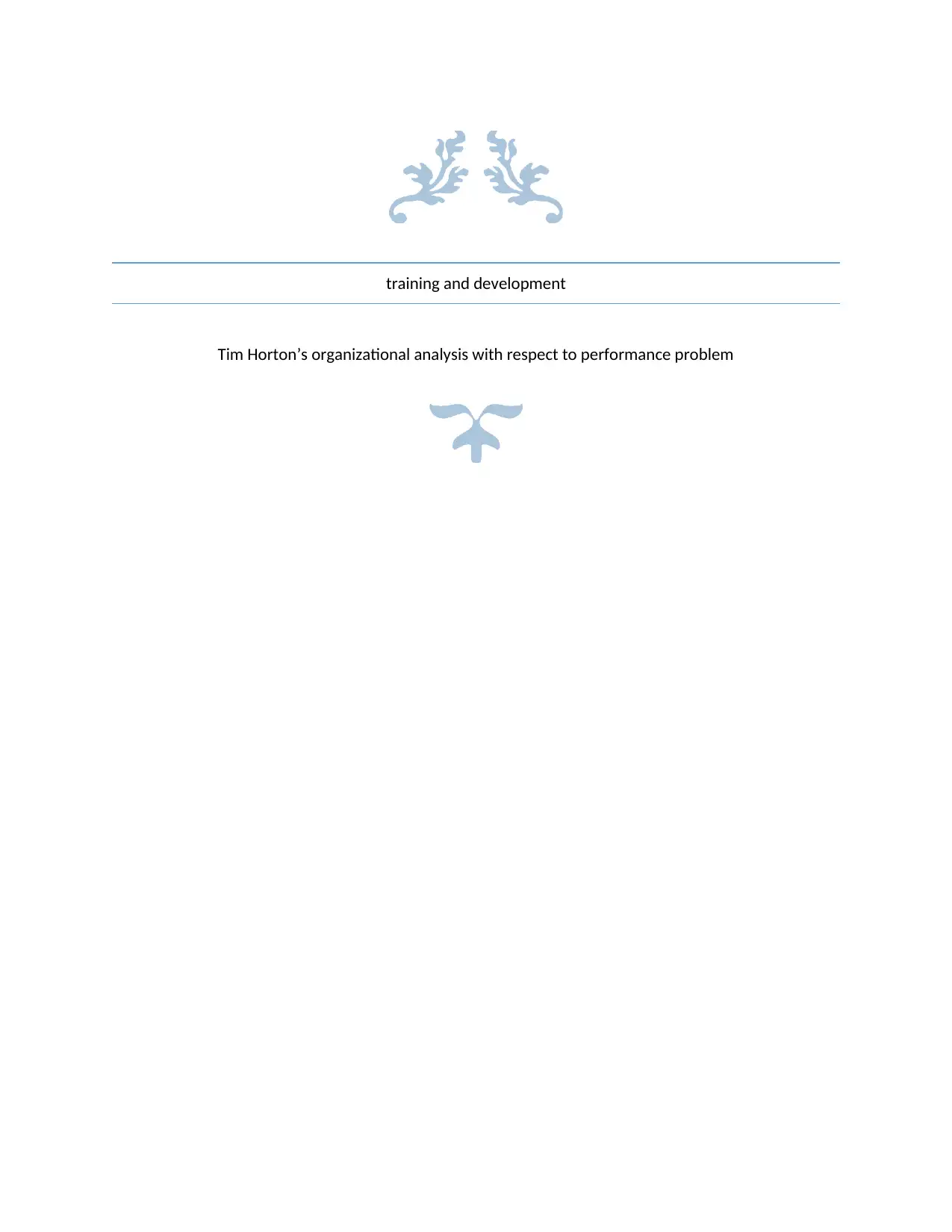
training and development
Tim Horton’s organizational analysis with respect to performance problem
Tim Horton’s organizational analysis with respect to performance problem
Paraphrase This Document
Need a fresh take? Get an instant paraphrase of this document with our AI Paraphraser
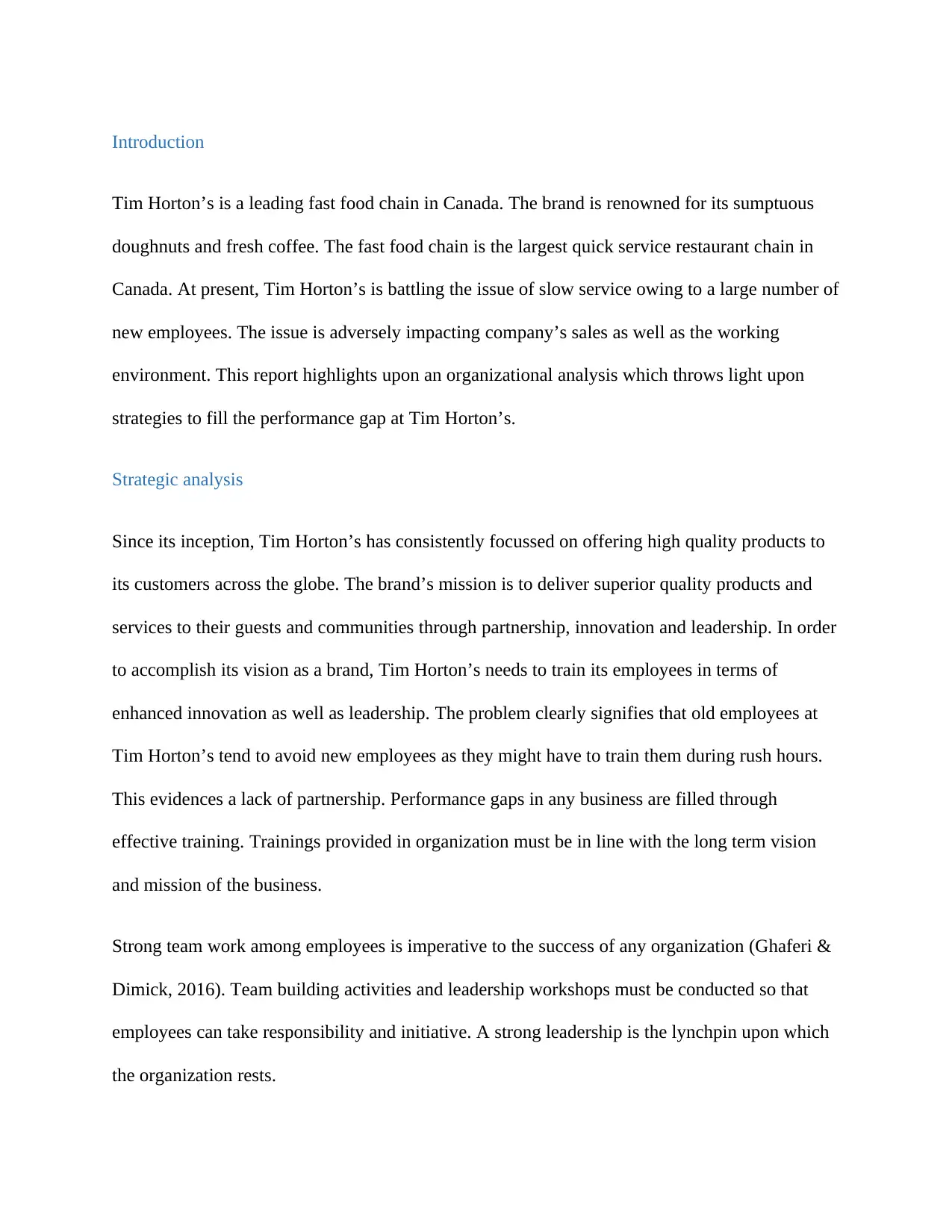
Introduction
Tim Horton’s is a leading fast food chain in Canada. The brand is renowned for its sumptuous
doughnuts and fresh coffee. The fast food chain is the largest quick service restaurant chain in
Canada. At present, Tim Horton’s is battling the issue of slow service owing to a large number of
new employees. The issue is adversely impacting company’s sales as well as the working
environment. This report highlights upon an organizational analysis which throws light upon
strategies to fill the performance gap at Tim Horton’s.
Strategic analysis
Since its inception, Tim Horton’s has consistently focussed on offering high quality products to
its customers across the globe. The brand’s mission is to deliver superior quality products and
services to their guests and communities through partnership, innovation and leadership. In order
to accomplish its vision as a brand, Tim Horton’s needs to train its employees in terms of
enhanced innovation as well as leadership. The problem clearly signifies that old employees at
Tim Horton’s tend to avoid new employees as they might have to train them during rush hours.
This evidences a lack of partnership. Performance gaps in any business are filled through
effective training. Trainings provided in organization must be in line with the long term vision
and mission of the business.
Strong team work among employees is imperative to the success of any organization (Ghaferi &
Dimick, 2016). Team building activities and leadership workshops must be conducted so that
employees can take responsibility and initiative. A strong leadership is the lynchpin upon which
the organization rests.
Tim Horton’s is a leading fast food chain in Canada. The brand is renowned for its sumptuous
doughnuts and fresh coffee. The fast food chain is the largest quick service restaurant chain in
Canada. At present, Tim Horton’s is battling the issue of slow service owing to a large number of
new employees. The issue is adversely impacting company’s sales as well as the working
environment. This report highlights upon an organizational analysis which throws light upon
strategies to fill the performance gap at Tim Horton’s.
Strategic analysis
Since its inception, Tim Horton’s has consistently focussed on offering high quality products to
its customers across the globe. The brand’s mission is to deliver superior quality products and
services to their guests and communities through partnership, innovation and leadership. In order
to accomplish its vision as a brand, Tim Horton’s needs to train its employees in terms of
enhanced innovation as well as leadership. The problem clearly signifies that old employees at
Tim Horton’s tend to avoid new employees as they might have to train them during rush hours.
This evidences a lack of partnership. Performance gaps in any business are filled through
effective training. Trainings provided in organization must be in line with the long term vision
and mission of the business.
Strong team work among employees is imperative to the success of any organization (Ghaferi &
Dimick, 2016). Team building activities and leadership workshops must be conducted so that
employees can take responsibility and initiative. A strong leadership is the lynchpin upon which
the organization rests.
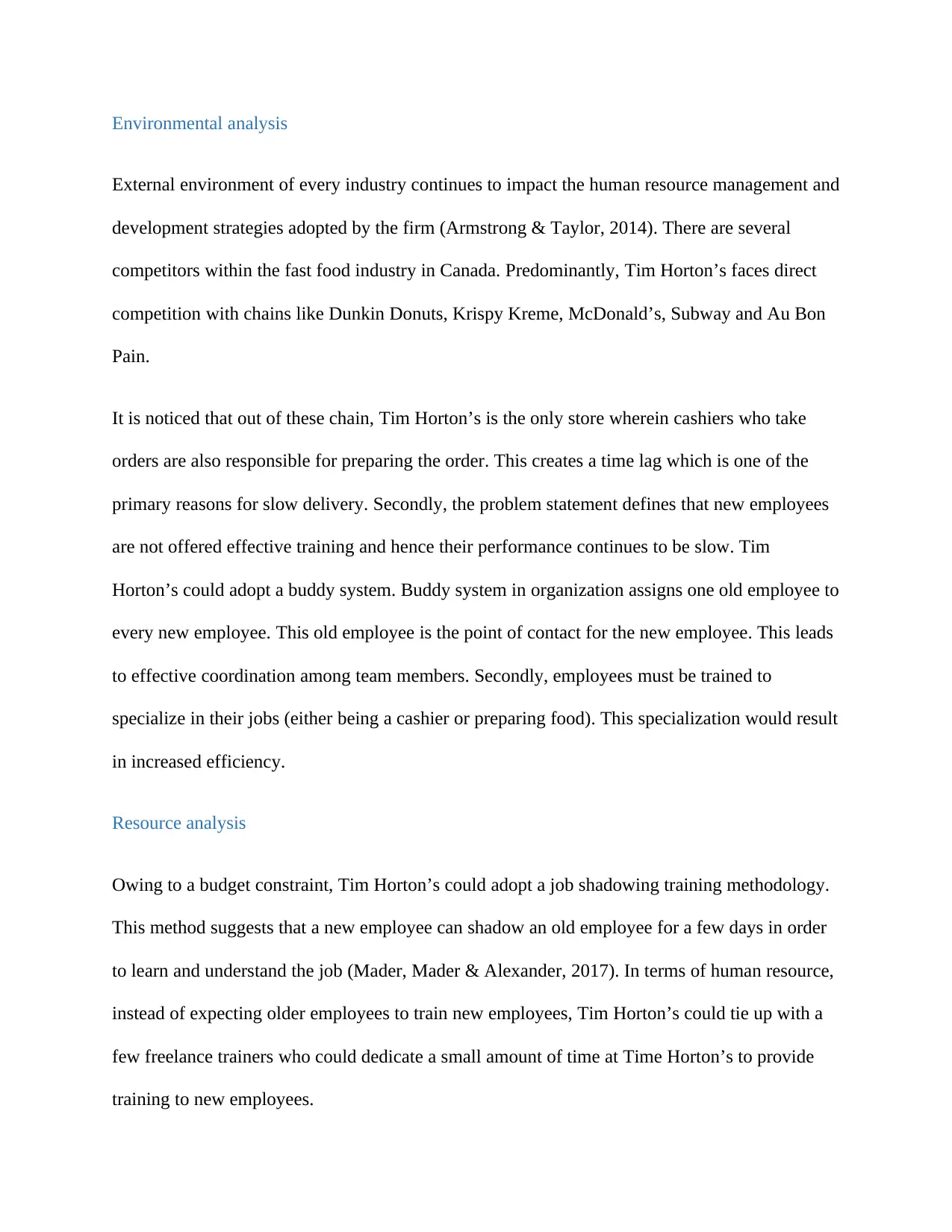
Environmental analysis
External environment of every industry continues to impact the human resource management and
development strategies adopted by the firm (Armstrong & Taylor, 2014). There are several
competitors within the fast food industry in Canada. Predominantly, Tim Horton’s faces direct
competition with chains like Dunkin Donuts, Krispy Kreme, McDonald’s, Subway and Au Bon
Pain.
It is noticed that out of these chain, Tim Horton’s is the only store wherein cashiers who take
orders are also responsible for preparing the order. This creates a time lag which is one of the
primary reasons for slow delivery. Secondly, the problem statement defines that new employees
are not offered effective training and hence their performance continues to be slow. Tim
Horton’s could adopt a buddy system. Buddy system in organization assigns one old employee to
every new employee. This old employee is the point of contact for the new employee. This leads
to effective coordination among team members. Secondly, employees must be trained to
specialize in their jobs (either being a cashier or preparing food). This specialization would result
in increased efficiency.
Resource analysis
Owing to a budget constraint, Tim Horton’s could adopt a job shadowing training methodology.
This method suggests that a new employee can shadow an old employee for a few days in order
to learn and understand the job (Mader, Mader & Alexander, 2017). In terms of human resource,
instead of expecting older employees to train new employees, Tim Horton’s could tie up with a
few freelance trainers who could dedicate a small amount of time at Time Horton’s to provide
training to new employees.
External environment of every industry continues to impact the human resource management and
development strategies adopted by the firm (Armstrong & Taylor, 2014). There are several
competitors within the fast food industry in Canada. Predominantly, Tim Horton’s faces direct
competition with chains like Dunkin Donuts, Krispy Kreme, McDonald’s, Subway and Au Bon
Pain.
It is noticed that out of these chain, Tim Horton’s is the only store wherein cashiers who take
orders are also responsible for preparing the order. This creates a time lag which is one of the
primary reasons for slow delivery. Secondly, the problem statement defines that new employees
are not offered effective training and hence their performance continues to be slow. Tim
Horton’s could adopt a buddy system. Buddy system in organization assigns one old employee to
every new employee. This old employee is the point of contact for the new employee. This leads
to effective coordination among team members. Secondly, employees must be trained to
specialize in their jobs (either being a cashier or preparing food). This specialization would result
in increased efficiency.
Resource analysis
Owing to a budget constraint, Tim Horton’s could adopt a job shadowing training methodology.
This method suggests that a new employee can shadow an old employee for a few days in order
to learn and understand the job (Mader, Mader & Alexander, 2017). In terms of human resource,
instead of expecting older employees to train new employees, Tim Horton’s could tie up with a
few freelance trainers who could dedicate a small amount of time at Time Horton’s to provide
training to new employees.
⊘ This is a preview!⊘
Do you want full access?
Subscribe today to unlock all pages.

Trusted by 1+ million students worldwide
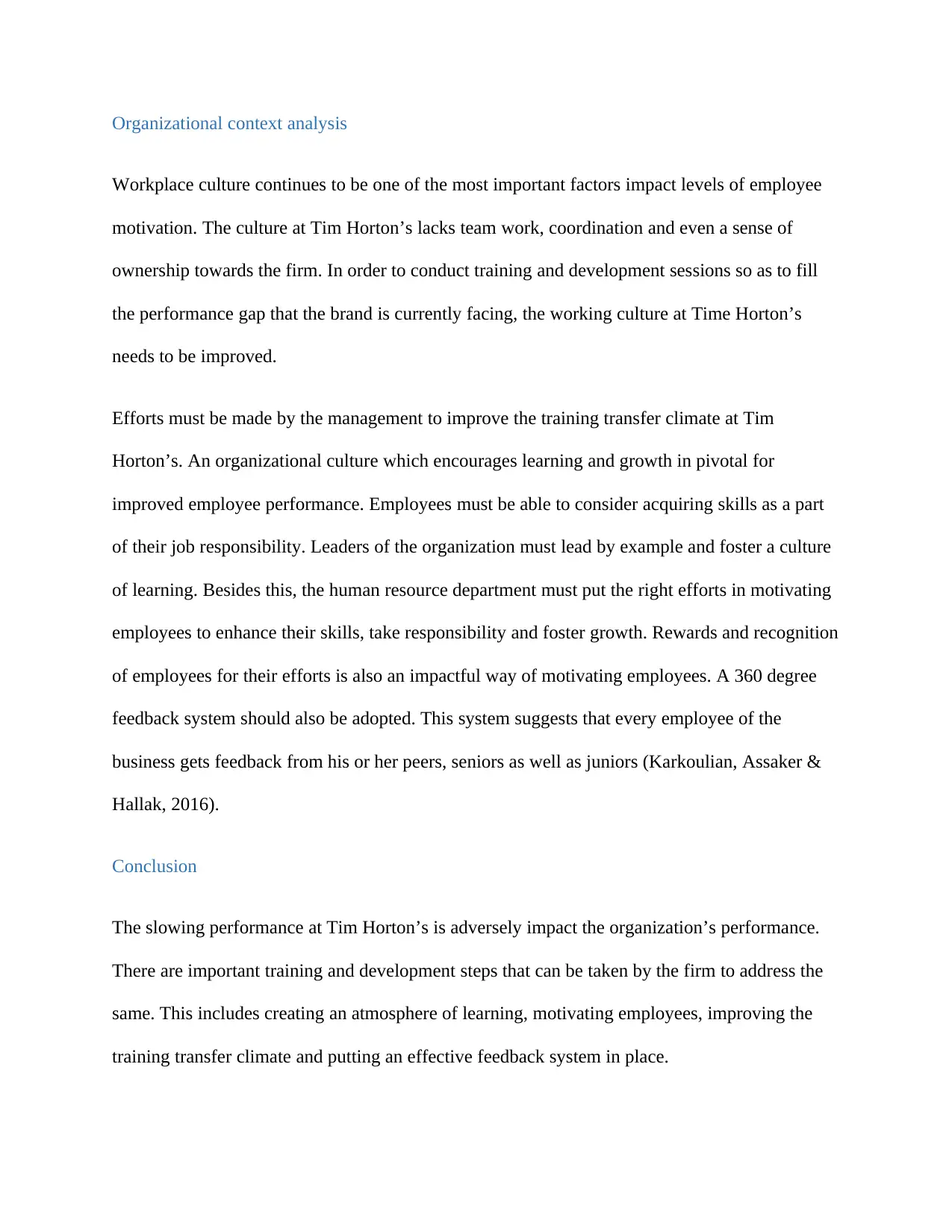
Organizational context analysis
Workplace culture continues to be one of the most important factors impact levels of employee
motivation. The culture at Tim Horton’s lacks team work, coordination and even a sense of
ownership towards the firm. In order to conduct training and development sessions so as to fill
the performance gap that the brand is currently facing, the working culture at Time Horton’s
needs to be improved.
Efforts must be made by the management to improve the training transfer climate at Tim
Horton’s. An organizational culture which encourages learning and growth in pivotal for
improved employee performance. Employees must be able to consider acquiring skills as a part
of their job responsibility. Leaders of the organization must lead by example and foster a culture
of learning. Besides this, the human resource department must put the right efforts in motivating
employees to enhance their skills, take responsibility and foster growth. Rewards and recognition
of employees for their efforts is also an impactful way of motivating employees. A 360 degree
feedback system should also be adopted. This system suggests that every employee of the
business gets feedback from his or her peers, seniors as well as juniors (Karkoulian, Assaker &
Hallak, 2016).
Conclusion
The slowing performance at Tim Horton’s is adversely impact the organization’s performance.
There are important training and development steps that can be taken by the firm to address the
same. This includes creating an atmosphere of learning, motivating employees, improving the
training transfer climate and putting an effective feedback system in place.
Workplace culture continues to be one of the most important factors impact levels of employee
motivation. The culture at Tim Horton’s lacks team work, coordination and even a sense of
ownership towards the firm. In order to conduct training and development sessions so as to fill
the performance gap that the brand is currently facing, the working culture at Time Horton’s
needs to be improved.
Efforts must be made by the management to improve the training transfer climate at Tim
Horton’s. An organizational culture which encourages learning and growth in pivotal for
improved employee performance. Employees must be able to consider acquiring skills as a part
of their job responsibility. Leaders of the organization must lead by example and foster a culture
of learning. Besides this, the human resource department must put the right efforts in motivating
employees to enhance their skills, take responsibility and foster growth. Rewards and recognition
of employees for their efforts is also an impactful way of motivating employees. A 360 degree
feedback system should also be adopted. This system suggests that every employee of the
business gets feedback from his or her peers, seniors as well as juniors (Karkoulian, Assaker &
Hallak, 2016).
Conclusion
The slowing performance at Tim Horton’s is adversely impact the organization’s performance.
There are important training and development steps that can be taken by the firm to address the
same. This includes creating an atmosphere of learning, motivating employees, improving the
training transfer climate and putting an effective feedback system in place.
Paraphrase This Document
Need a fresh take? Get an instant paraphrase of this document with our AI Paraphraser
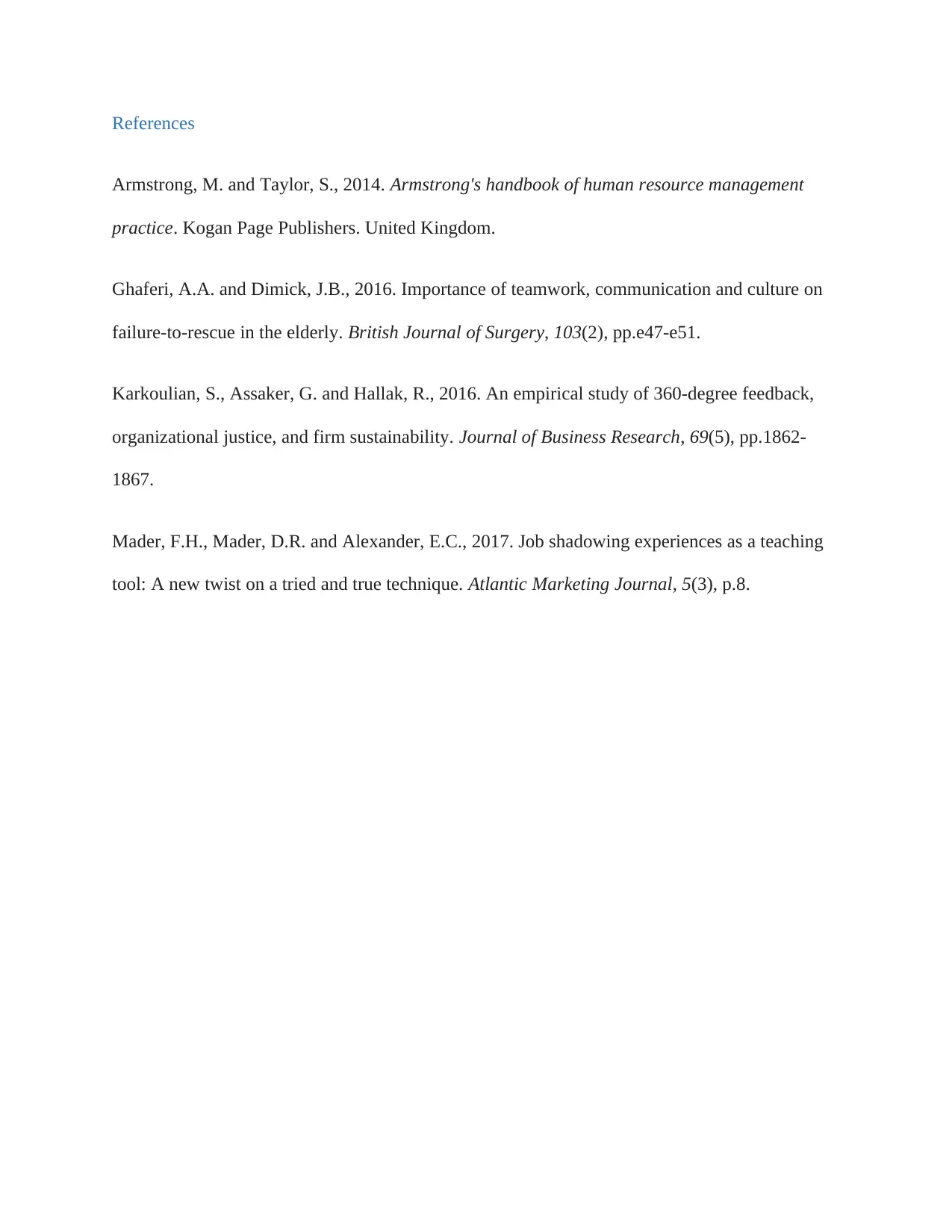
References
Armstrong, M. and Taylor, S., 2014. Armstrong's handbook of human resource management
practice. Kogan Page Publishers. United Kingdom.
Ghaferi, A.A. and Dimick, J.B., 2016. Importance of teamwork, communication and culture on
failure‐to‐rescue in the elderly. British Journal of Surgery, 103(2), pp.e47-e51.
Karkoulian, S., Assaker, G. and Hallak, R., 2016. An empirical study of 360-degree feedback,
organizational justice, and firm sustainability. Journal of Business Research, 69(5), pp.1862-
1867.
Mader, F.H., Mader, D.R. and Alexander, E.C., 2017. Job shadowing experiences as a teaching
tool: A new twist on a tried and true technique. Atlantic Marketing Journal, 5(3), p.8.
Armstrong, M. and Taylor, S., 2014. Armstrong's handbook of human resource management
practice. Kogan Page Publishers. United Kingdom.
Ghaferi, A.A. and Dimick, J.B., 2016. Importance of teamwork, communication and culture on
failure‐to‐rescue in the elderly. British Journal of Surgery, 103(2), pp.e47-e51.
Karkoulian, S., Assaker, G. and Hallak, R., 2016. An empirical study of 360-degree feedback,
organizational justice, and firm sustainability. Journal of Business Research, 69(5), pp.1862-
1867.
Mader, F.H., Mader, D.R. and Alexander, E.C., 2017. Job shadowing experiences as a teaching
tool: A new twist on a tried and true technique. Atlantic Marketing Journal, 5(3), p.8.
1 out of 5
Your All-in-One AI-Powered Toolkit for Academic Success.
+13062052269
info@desklib.com
Available 24*7 on WhatsApp / Email
![[object Object]](/_next/static/media/star-bottom.7253800d.svg)
Unlock your academic potential
Copyright © 2020–2025 A2Z Services. All Rights Reserved. Developed and managed by ZUCOL.
